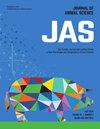Effects of corn protein inclusion on apparent total tract macronutrient digestibility, palatability, and fecal characteristics, microbiota, and metabolites of healthy adult dogs
IF 2.7
2区 农林科学
Q1 AGRICULTURE, DAIRY & ANIMAL SCIENCE
引用次数: 0
Abstract
Corn protein (CP), a co-product of the corn ethanol industry, is a sustainable protein source used in pet foods. The objectives of this study were to determine the palatability and apparent total tract digestibility (ATTD) of diets containing CP and to test the effects of CP-containing diets on the serum metabolites, hematology, and fecal characteristics, metabolites, and microbiota of healthy adult dogs. Ten female adult beagles (mean age: 6.12±1.39 yr; mean body weight: 9.33±1.04 kg) were used in a replicated 5x5 Latin square design (n=10/treatment). All dietary treatments were based on brewers rice, low-ash chicken byproduct meal, and chicken fat, and contained variable amounts of corn-based proteins: 0% (control), 15.3% corn gluten meal (CGM), 10.2% CGM + 5% CP (Low), 5.1% CGM + 10% CP (Medium), and 15% CP (High). The experiment was composed of five 28-day periods, with each consisting of a 22-day diet consumption period, a 5-day fecal collection period, and 1 day for blood collection. Data were analyzed statistically by Mixed Models using SAS 9.4, with P<0.05 accepted as being statistically significant. Two 2-day palatability studies (n=20 dogs) were also conducted to compare the High diet vs. control diet and High diet vs. CGM diet. Dogs were shown to prefer (P<0.05) the High diet over the control diet by a ratio of 1.8:1, but no preference was observed between the High and CGM diets. In the digestibility study, the ATTD of dry matter, organic matter, and energy increased (P<0.001) linearly with CP inclusion. The ATTD of fat was greater (P<0.001) for the control diet than for the CGM, Low, and High diets. Fecal scores were lower (P=0.05; firmer) and fecal dry matter percentage was higher (P<0.0001) in dogs fed CGM than those fed CP. Fecal phenol and indole, short-chain fatty acid, and branched-chain fatty acid concentrations were greater (P<0.05) in dogs fed CP than dogs fed CGM and control. Fecal bacterial diversity was not altered by diet, but the relative abundance of approximately 10 bacterial genera was altered by diet. In summary, our data demonstrate that the inclusion of CP in dog foods resulted in high diet palatability and macronutrient digestibility and altered microbial composition and activity.玉米蛋白包埋对健康成年犬全肠道宏量营养素表观消化率、适口性、粪便特征、微生物群和代谢物的影响
玉米蛋白(CP)是玉米乙醇工业的副产品,是一种用于宠物食品的可持续蛋白质来源。本研究的目的是确定含CP饲粮的适口性和表观全道消化率(ATTD),并测试含CP饲粮对健康成年犬血清代谢物、血液学、粪便特征、代谢物和微生物群的影响。成年雌比格犬10只,平均年龄6.12±1.39岁;平均体重:9.33±1.04 kg),采用重复5 × 5拉丁方设计(n=10/处理)。所有饲粮处理均以啤酒米、低灰分鸡副产品粕和鸡脂肪为基础,并含有不同数量的玉米蛋白:0%(对照)、15.3%玉米蛋白粉(CGM)、10.2%玉米蛋白粉+ 5% CP(低)、5.1%玉米蛋白粉+ 10% CP(中)和15% CP(高)。试验分为5个28 d阶段,每个阶段包括22 d的饮食消耗期、5 d的粪便收集期和1 d的采血期。数据采用SAS 9.4混合模型进行统计学分析,以P&;lt;0.05为差异有统计学意义。还进行了两项为期2天的适口性研究(n=20只狗),以比较高饲粮与对照饲粮以及高饲粮与CGM饲粮。结果显示,狗对High饲粮的偏好(P<0.05)高于对照饲粮,比例为1.8:1,但在High饲粮和CGM饲粮之间没有发现偏好。在消化率研究中,干物质、有机物和能量的ATTD随CP包合呈线性增加(P<0.001)。对照饮食中脂肪的ATTD比CGM、Low和High饮食中脂肪的ATTD更大(P<0.001)。粪便评分较低(P=0.05;CGM组粪便干物质百分比高于CP组(P<0.0001), CP组粪便中苯酚、吲哚、短链脂肪酸和支链脂肪酸浓度高于CGM组和对照组(P<0.05)。饮食没有改变粪便细菌的多样性,但饮食改变了大约10种细菌属的相对丰度。综上所述,我们的数据表明,在狗粮中加入CP会提高狗粮的适口性和宏量营养素的消化率,并改变微生物的组成和活性。
本文章由计算机程序翻译,如有差异,请以英文原文为准。
求助全文
约1分钟内获得全文
求助全文
来源期刊

Journal of animal science
农林科学-奶制品与动物科学
CiteScore
4.80
自引率
12.10%
发文量
1589
审稿时长
3 months
期刊介绍:
The Journal of Animal Science (JAS) is the premier journal for animal science and serves as the leading source of new knowledge and perspective in this area. JAS publishes more than 500 fully reviewed research articles, invited reviews, technical notes, and letters to the editor each year.
Articles published in JAS encompass a broad range of research topics in animal production and fundamental aspects of genetics, nutrition, physiology, and preparation and utilization of animal products. Articles typically report research with beef cattle, companion animals, goats, horses, pigs, and sheep; however, studies involving other farm animals, aquatic and wildlife species, and laboratory animal species that address fundamental questions related to livestock and companion animal biology will be considered for publication.
 求助内容:
求助内容: 应助结果提醒方式:
应助结果提醒方式:


